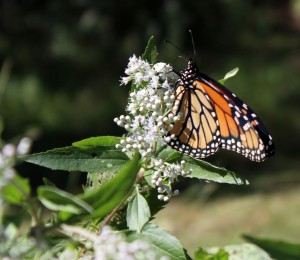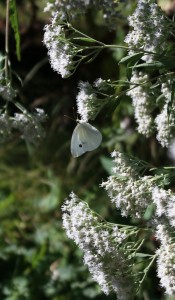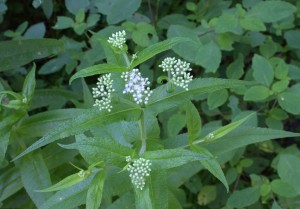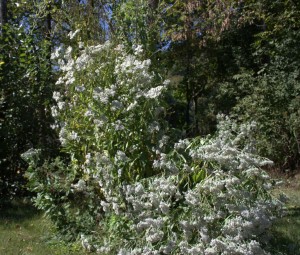The prettiest, late-blooming plant this year for me was a new one, too. New to me, yet quite familiar.
This plant seemed so familiar, but there was something different about it. Mainly its size as it was taller than me and shrubbery-like.

The Late-Flowering Thoroughwort caught my attention partially because it attracted butterflies like crazy and partially because of its sweet scent. Photos taken 14 September 2015.

Similar-looking clusters of flowers occur in a couple of dozen related plants that bloom in late summer to early autumn in Central Pennsylvania. We’ve been able to spot three of them:
- White Snakeroot, Ageratina altissima, formerly known as Eupatorium rugosum
- Boneset, E. perfoliatum
- Late-Flowering Thoroughwort, E. serotinum
Indeed, the way to tell these similar-looking plants apart is to look at their leaves and leaf attachment, not their flowers. Unfortunately, my camera was more focused on the butterflies this day, but the first photo with the monarch shows a little of the leaf shape. Better photos showing the leaves and other plant parts will have to wait for next year.
White Snake Root grows all up and down our gravel lane to the highway, so it’s a familiar plant. We see it along the country roads everywhere around here. It’s especially noticeable when in bloom. Leaves are attached in pairs, opposite fashion, having purple-hued stems and wider leaf bases making heart-shaped leaves.

Boneset is much less common although it appears in the same type of locations as its cousin, White Snake Root. It grows taller than White Snakeroot and its leaves are quite distinct, attached oppositely, sessile with no leaf stem, and attached to each other so that the main stem appears to perforate them. It is a hairy plant with wrinkly leaves.

New for me this year was another Eupatorium species. I found a specimen in our local park that had flowers very much like White Snake Root and Boneset. It turns out that this attractive wildflower is another Thoroughwort from the Asteraceae Family, specifically Lateflowering Thoroughwort. Its leaves have fairly long stems, or petioles. Leaf edges are scalloped and not as wide as those of White Snakeroot. Native to at least the Eastern half of the United States.

Clusters of small white flowers with a “floral” scent that reminds one of the smell of a flower bouquet from a flower shop. Not sure what that scent is, but most would call it a flowery fragrance. Similar smell from all three plants, but so many more flowers in bloom on the shrub-like Late-Flowering Thoroughwort make it the winner of the sweet scent contest.
Looking forward to seeing these plants bloom again next summer!